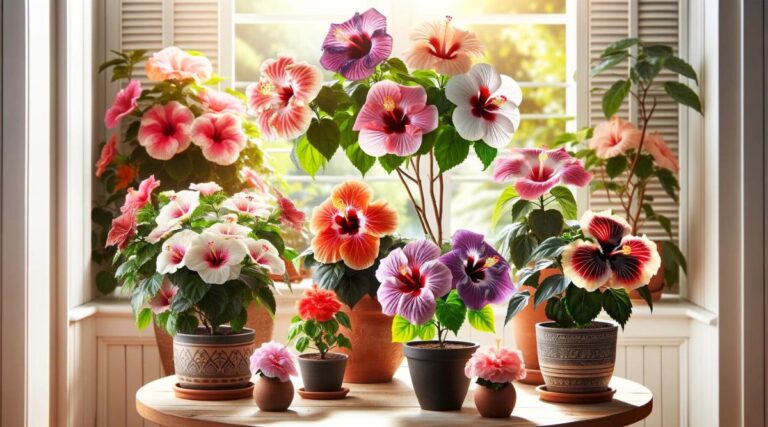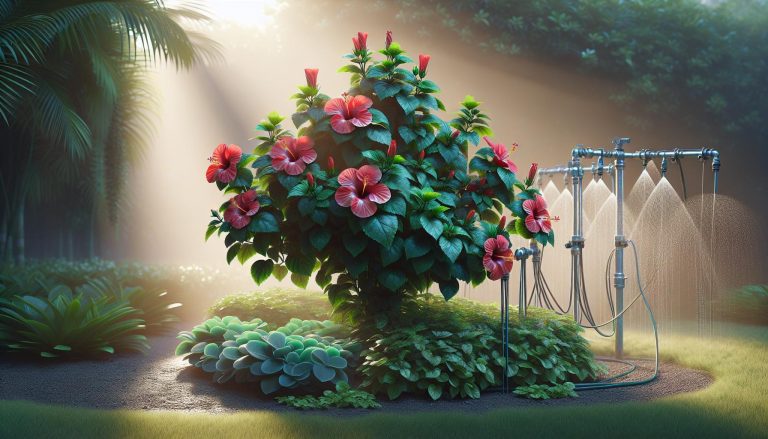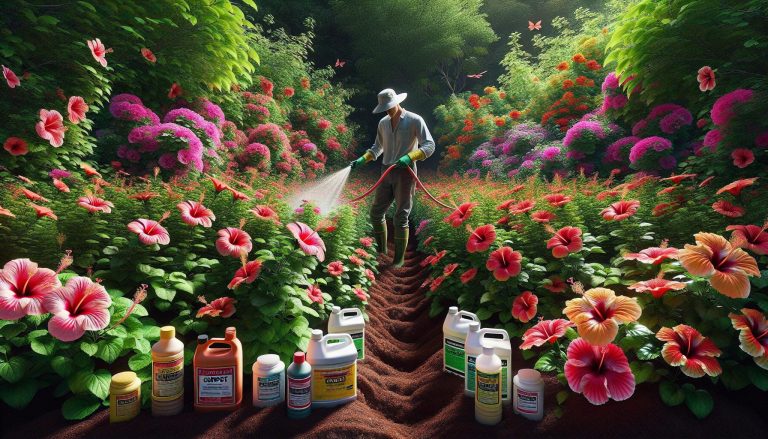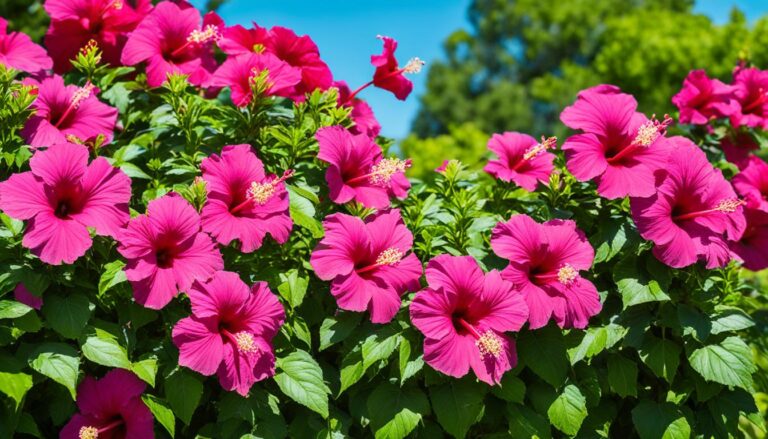Can Hibiscus Survive Winter Outside? Tips for Cold-Hardy Varieties
As a passionate gardener, I’ve often marveled at the vibrant beauty of hibiscus flowers. But when winter approaches, a common question arises: can these tropical beauties survive the cold outdoors?
The answer isn’t straightforward, as it depends on various factors like hibiscus species, climate zone, and winter care practices. While some hardy hibiscus varieties can withstand freezing temperatures, tropical types are more susceptible to cold damage. Did you know that some hibiscus plants can survive temperatures as low as 20°F (-6°C)? I’ll explore the fascinating world of hibiscus winter survival and share essential tips to help your plants thrive year-round.
Understanding Hibiscus Plants and Their Cold Tolerance
Hibiscus plants vary in their ability to withstand cold temperatures, depending on their species and origin. I’ll explore the different types of hibiscus and their hardiness zones to help you understand which varieties can survive winter outdoors.
Different Types of Hibiscus
Hibiscus plants are categorized into three main types:
- Tropical hibiscus (Hibiscus rosa-sinensis): Native to warm climates, these plants are sensitive to cold temperatures.
- Hardy hibiscus (Hibiscus moscheutos): Also known as rose mallow, these plants can withstand colder temperatures.
- Rose of Sharon (Hibiscus syriacus): A deciduous shrub that’s more cold-tolerant than tropical varieties.
Tropical hibiscus plants produce vibrant, exotic flowers but are least resistant to cold. Hardy hibiscus and Rose of Sharon are better suited for colder regions, with some varieties tolerating temperatures as low as 0°F (-18°C).
Hardiness Zones for Hibiscus
Hardiness zones determine which plants can thrive in specific geographic areas based on average annual minimum winter temperatures. For hibiscus:
- Tropical hibiscus: Zones 9-11
- Hardy hibiscus: Zones 4-9
- Rose of Sharon: Zones 5-9
| Hibiscus Type | USDA Hardiness Zones | Minimum Temperature Tolerance |
|---|---|---|
| Tropical | 9-11 | 20°F (-6°C) |
| Hardy | 4-9 | -30°F (-34°C) |
| Rose of Sharon | 5-9 | -20°F (-29°C) |
To determine if your hibiscus can survive winter outside, identify your plant’s type and your local hardiness zone. This information helps you make informed decisions about winter care and protection for your hibiscus plants.
Factors Affecting Hibiscus Winter Survival

Several key factors influence whether hibiscus can survive winter outdoors. Understanding these elements is crucial for maintaining healthy hibiscus plants during colder months.
Temperature Thresholds
Temperature thresholds play a critical role in hibiscus winter survival. Tropical hibiscus varieties struggle in temperatures below 50°F (10°C), while hardy hibiscus can withstand temperatures as low as -20°F (-29°C). Prolonged exposure to freezing temperatures causes cellular damage, leading to wilting, leaf drop, and potential plant death. Sudden temperature fluctuations, particularly freeze-thaw cycles, are especially harmful as they can cause root damage and disrupt the plant’s dormancy.
Soil Conditions and Moisture
Soil conditions and moisture levels significantly impact hibiscus winter hardiness. Well-draining soil is essential to prevent root rot, which becomes more likely in cold, waterlogged conditions. Sandy or loamy soils with good drainage are ideal. Adequate soil moisture helps insulate roots, but excess water can lead to frost heave, damaging root systems. Adding a 2-3 inch layer of mulch around the base of the plant helps regulate soil temperature and moisture, providing crucial protection during winter months.
Wind Exposure
Wind exposure is a often-overlooked factor in hibiscus winter survival. Strong, cold winds can cause desiccation, leading to dry, brittle stems and buds. Plants in exposed locations are more susceptible to winter damage than those in sheltered areas. Windbreaks, such as fences, walls, or dense evergreen plantings, can significantly reduce wind stress on hibiscus plants. Wrapping plants in burlap or using temporary wind barriers during the coldest months provides additional protection against harsh winter winds.
Protecting Hibiscus Plants During Winter
Protecting hibiscus plants during winter is crucial for their survival, especially in colder regions. I’ll outline effective strategies to safeguard these plants from harsh winter conditions.
Mulching Techniques
Mulching is essential for insulating hibiscus roots from freezing temperatures. I apply a 3-4 inch layer of organic mulch, such as straw, leaves, or bark chips, around the base of the plant. This protective barrier helps maintain soil temperature and retains moisture. For added protection, I extend the mulch coverage to the plant’s drip line, ensuring the entire root system benefits from the insulation.
Winter Coverings and Shelters
Coverings and shelters provide vital protection for hibiscus plants during winter. I use burlap or frost cloth to wrap the entire plant, securing it with stakes or ties. For potted hibiscus, I move them to a sheltered area like a garage or sunroom where temperatures remain above freezing. In severe climates, I construct a sturdy frame around the plant and cover it with plastic sheeting, creating a greenhouse effect that traps heat and shields against wind and snow.
Proper Watering Practices
Correct watering is crucial for hibiscus winter survival. I reduce watering frequency as temperatures drop, but ensure the soil remains slightly moist to prevent dehydration. Before the first frost, I water the plant deeply to provide adequate moisture throughout winter. During occasional warm spells, I check the soil and water lightly if it’s dry. For potted hibiscus, I water sparingly, only when the top inch of soil feels dry to the touch, preventing root rot from excess moisture in colder temperatures.
Preparing Hibiscus for Cold Weather
Preparing hibiscus for cold weather is crucial for their survival during winter months. By implementing the right techniques, you can significantly increase your hibiscus plants’ chances of thriving through harsh conditions.
Fall Pruning Tips
Fall pruning is essential for hibiscus winter preparation. I recommend pruning hibiscus plants in late fall, about 4-6 weeks before the first frost. This timing allows the plants to heal before winter sets in. Here’s how to prune effectively:
- Remove dead, diseased, or crossing branches
- Cut back 1/3 of the plant’s height to promote bushier growth
- Trim any long, leggy stems to maintain shape
- Use clean, sharp pruning shears to make clean cuts
Pruning reduces the plant’s size, making it easier to protect during winter. It also helps the hibiscus conserve energy for spring regrowth.
Fertilization Considerations
Proper fertilization before winter is crucial for hibiscus health. I advise adjusting your fertilization routine as follows:
- Stop fertilizing 6-8 weeks before the first expected frost
- Switch to a low-nitrogen, high-potassium fertilizer in late summer
- Apply a slow-release fertilizer in early fall to support root health
| Fertilizer Type | NPK Ratio | Application Time |
|---|---|---|
| Summer | 10-10-10 | Spring to Mid-Summer |
| Late Summer | 2-10-10 | Late Summer |
| Fall | 0-10-10 | Early Fall |
Reducing nitrogen intake prevents new growth that’s susceptible to frost damage. Increasing potassium helps strengthen cell walls, improving the plant’s cold tolerance. By following these fertilization guidelines, you’ll prepare your hibiscus for the challenges of winter while setting the stage for robust spring growth.
Overwintering Hibiscus Indoors
For tropical hibiscus varieties that can’t survive freezing temperatures, bringing them indoors is often the best solution. This method ensures their survival and allows for continued growth during the winter months.
Container Growing for Easy Relocation
Growing hibiscus in containers facilitates easy relocation when temperatures drop. I recommend using lightweight, portable containers with adequate drainage holes. Choose a pot that’s 2-3 inches larger than the plant’s root ball to allow for growth. Fill the container with a well-draining potting mix specifically designed for tropical plants. Before the first frost, gradually acclimate the plant to indoor conditions by moving it to a shaded area for a week, then bringing it inside. This process helps minimize stress and leaf drop during the transition.
Indoor Care Guidelines
Once indoors, hibiscus plants require specific care to thrive:
- Light: Place the plant near a south-facing window for maximum sunlight exposure.
- Temperature: Maintain temperatures between 55-70°F (13-21°C).
- Humidity: Use a pebble tray or humidifier to increase humidity levels to 50-60%.
- Watering: Reduce watering frequency, allowing the top inch of soil to dry between waterings.
- Fertilization: Apply a balanced, water-soluble fertilizer at half strength every 4-6 weeks.
- Pruning: Trim back leggy growth to maintain shape and encourage bushiness.
- Pest control: Inspect regularly for common indoor pests like spider mites and whiteflies.
By following these guidelines, hibiscus plants can successfully overwinter indoors and be ready for outdoor placement when spring arrives.
Varieties of Cold-Hardy Hibiscus
Cold-hardy hibiscus varieties offer gardeners in colder regions the opportunity to enjoy these beautiful flowers year-round. These plants are specifically bred to withstand lower temperatures and harsh winter conditions.
Rose of Sharon
Rose of Sharon (Hibiscus syriacus) is a popular cold-hardy hibiscus variety that thrives in USDA hardiness zones 5-9. It’s a deciduous shrub that can grow up to 12 feet tall and 10 feet wide. Rose of Sharon blooms from mid-summer to fall, producing large, showy flowers in various colors, including white, pink, purple, and blue. This variety is known for its ability to withstand temperatures as low as -20°F (-29°C) when properly established.
Key features of Rose of Sharon:
- Blooms: Late summer to fall
- Height: 8-12 feet
- Spread: 6-10 feet
- Sun exposure: Full sun to partial shade
- Soil requirements: Well-draining, slightly acidic to neutral
Swamp Hibiscus
Swamp Hibiscus (Hibiscus moscheutos), also known as Hardy Hibiscus or Rose Mallow, is another cold-hardy variety that can survive winter outdoors in USDA zones 4-9. This perennial hibiscus is native to wetland areas in North America and can tolerate temperatures as low as -30°F (-34°C). Swamp Hibiscus produces enormous flowers, often 6-12 inches in diameter, in shades of white, pink, and red.
Characteristics of Swamp Hibiscus:
- Blooms: Mid-summer to early fall
- Height: 3-7 feet
- Spread: 2-4 feet
- Sun exposure: Full sun
- Soil requirements: Moist to wet, rich in organic matter
Both Rose of Sharon and Swamp Hibiscus offer excellent cold hardiness while maintaining the stunning floral displays characteristic of the hibiscus family. These varieties allow gardeners in colder climates to enjoy hibiscus plants without the need for extensive winter protection or indoor storage.
Conclusion
Hibiscus winter survival depends on the variety and your local climate. While tropical types need protection or indoor care, hardy hibiscus and Rose of Sharon can thrive in colder regions. By understanding your plant’s needs and implementing proper winter care strategies, you’ll increase its chances of surviving harsh conditions. Whether you’re overwintering outdoors or bringing plants inside, careful attention to soil, moisture, and temperature will help your hibiscus flourish year after year. With the right knowledge and preparation, you can enjoy these stunning blooms regardless of your climate zone.







